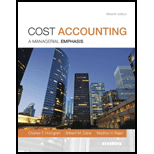
1.
To compute: The sales quantity variance for each product.
Given information:
Static budget total contribution margin is $15,525.
Budgeted units to be sold of all glasses are $2,300 units.
Budgeted contribution margin per unit of P is $5 per unit.
Budgeted contribution margin per unit of C is $12 per unit.
Total sales quantity variance is $2,700 unfavorable.
Actual sales mix percentage of plain is 60%.
2.
To compute: The individual product and total sales mix variance.
Given information:
Total actual unit sold is 1,900.
Budgeted sales mix of P is 0.75.
Actual sales mix percentage of plain is 60%.
Budgeted contribution margin per unit of P is $5 per unit.
Budgeted sales mix of C is 0.25.
Actual sales mix percentage of plain is 40%.
Budgeted contribution margin per unit of C is $12 per unit.
3.
To explain: The result of calculation of sales variance.
Want to see the full answer?
Check out a sample textbook solution
Chapter 14 Solutions
Cost Accounting: A Managerial Emphasis, 15th Edition
- On March 1, 20X1, your company,which uses Units-of-Production (UOP) Depreciation, purchases a machine for $300,000.arrow_forwardPlease provide the accurate answer to this general accounting problem using valid techniques.arrow_forwardI am searching for the right answer to this financial accounting question using proper techniques.arrow_forward
- Please explain the solution to this general accounting problem with accurate principles.arrow_forwardI am searching for the correct answer to this general accounting problem with proper accounting rules.arrow_forwardi will give unhelpful.blurr image please comment i will write values. please dont Solve with incorrect values otherwise unhelpful.arrow_forward

 AccountingAccountingISBN:9781337272094Author:WARREN, Carl S., Reeve, James M., Duchac, Jonathan E.Publisher:Cengage Learning,
AccountingAccountingISBN:9781337272094Author:WARREN, Carl S., Reeve, James M., Duchac, Jonathan E.Publisher:Cengage Learning, Accounting Information SystemsAccountingISBN:9781337619202Author:Hall, James A.Publisher:Cengage Learning,
Accounting Information SystemsAccountingISBN:9781337619202Author:Hall, James A.Publisher:Cengage Learning, Horngren's Cost Accounting: A Managerial Emphasis...AccountingISBN:9780134475585Author:Srikant M. Datar, Madhav V. RajanPublisher:PEARSON
Horngren's Cost Accounting: A Managerial Emphasis...AccountingISBN:9780134475585Author:Srikant M. Datar, Madhav V. RajanPublisher:PEARSON Intermediate AccountingAccountingISBN:9781259722660Author:J. David Spiceland, Mark W. Nelson, Wayne M ThomasPublisher:McGraw-Hill Education
Intermediate AccountingAccountingISBN:9781259722660Author:J. David Spiceland, Mark W. Nelson, Wayne M ThomasPublisher:McGraw-Hill Education Financial and Managerial AccountingAccountingISBN:9781259726705Author:John J Wild, Ken W. Shaw, Barbara Chiappetta Fundamental Accounting PrinciplesPublisher:McGraw-Hill Education
Financial and Managerial AccountingAccountingISBN:9781259726705Author:John J Wild, Ken W. Shaw, Barbara Chiappetta Fundamental Accounting PrinciplesPublisher:McGraw-Hill Education





